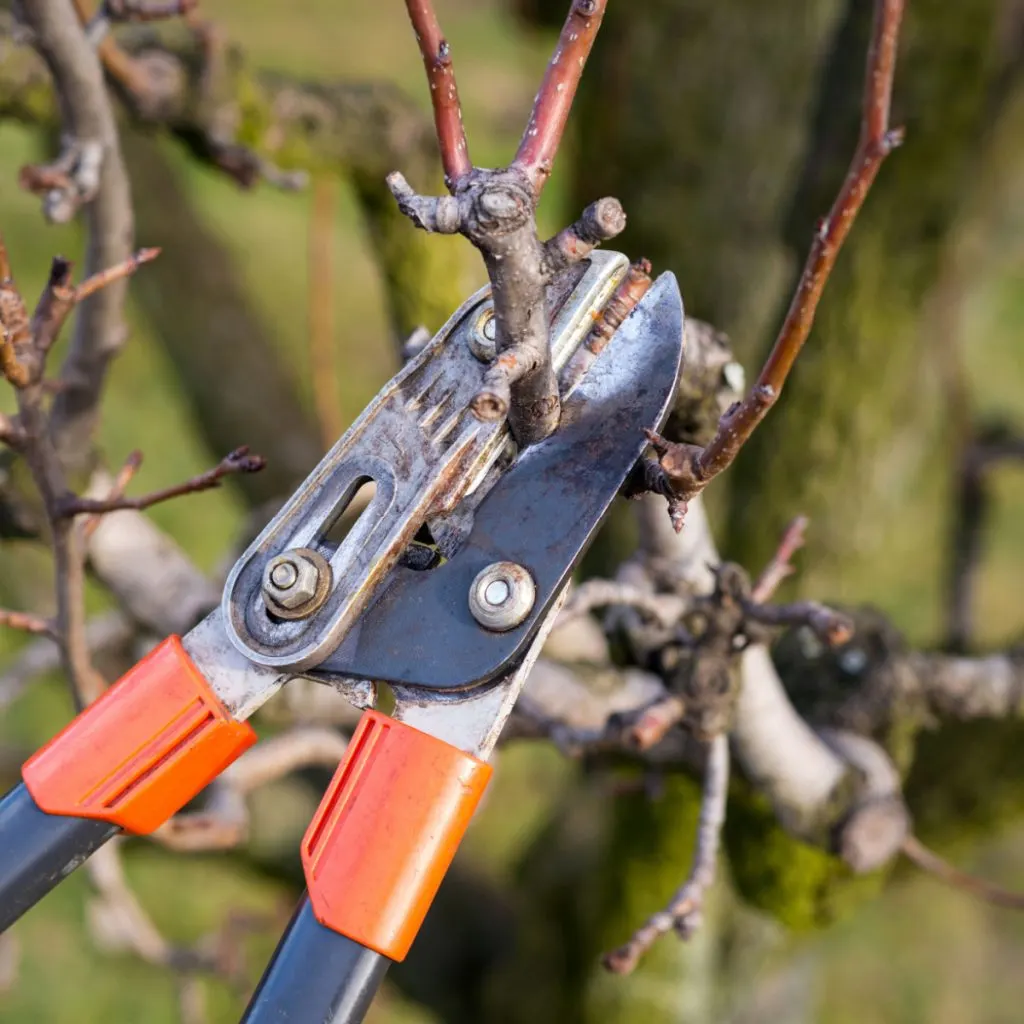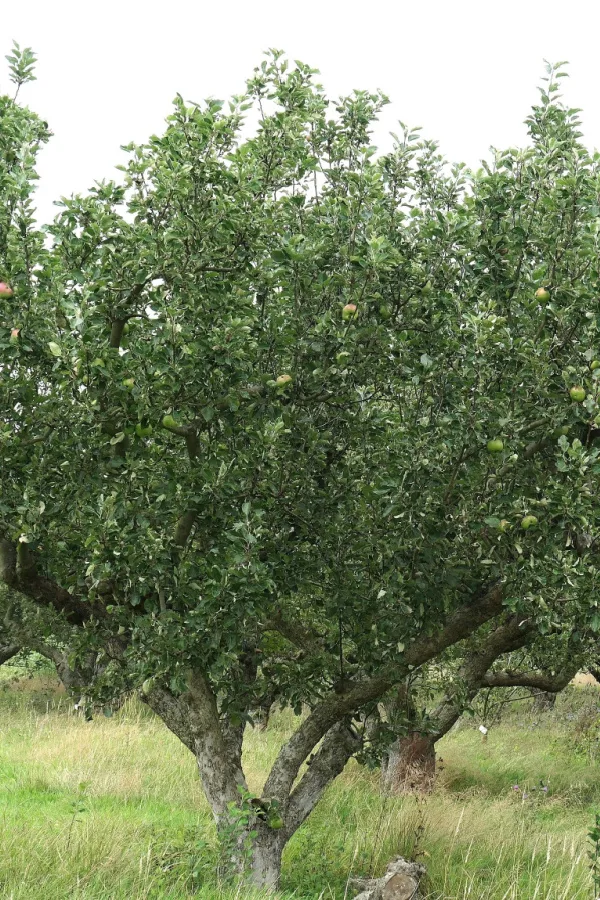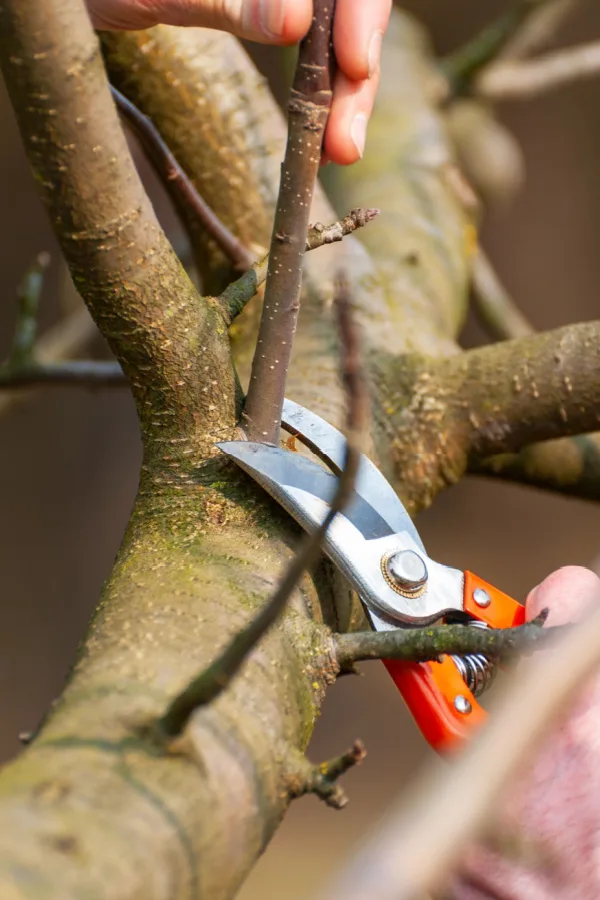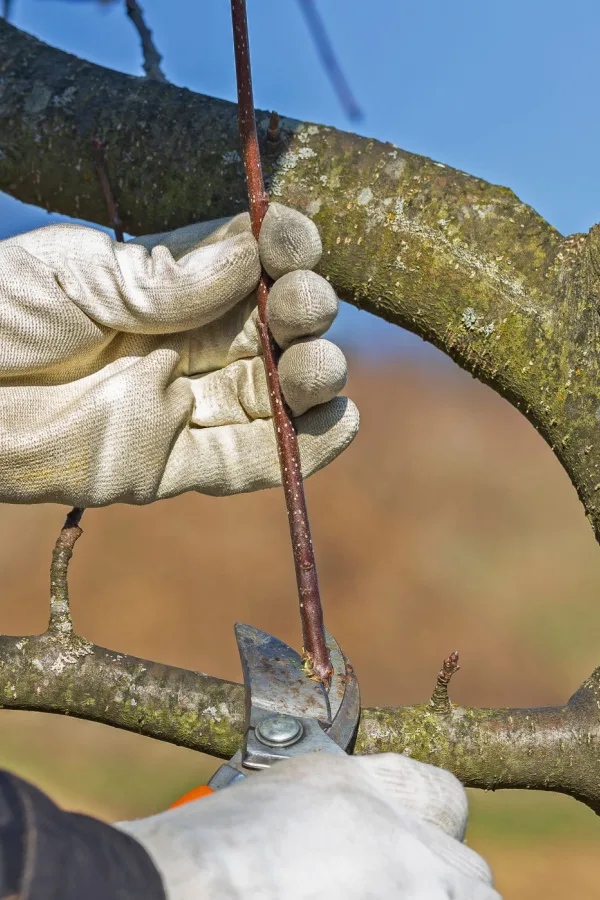Did you know that the absolute best time for pruning your apple trees is in the dead of winter? In fact, it’s really the only time you should prune your apples trees!
Not only does winter pruning allow you to shape and trim back your trees without worry of harming them or your next harvest, it also helps your trees stay healthy and strong – and even better – be fully prepared for a bigger and better harvest the following summer.
When it comes to pruning apple and other fruit trees, many gardeners are a bit intimidated by the process. The good news is that pruning fruit trees is not as difficult or overwhelming as it might appear on the surface. As it turns out, it’s actually a fairly simple chore that can be done in no time at all. Especially during the winter months.

While the fall months are a perfect time to prune many perennial plants before winter sets in, it isn’t the best option for apple trees. This is because the act of pruning stimulates new growth. Growth that is then highly susceptible to winter damage.
As apple trees prepare for winter and head into dormancy, new fall growth that appears after pruning simply doesn’t have time to mature. Nor do the cuts have time to harden off or heal before winter arrives. And that leaves an apple tree highly vulnerable to the harsh conditions winter brings.
Why Winter Is The Time For Pruning Apple Trees
Although apple trees can be pruned more safely in the spring and summer months, pruning in the winter still has far more advantages. Both for the trees and the pruner!
For starters, with their leaves gone for the season, branches are easy to see and cut. That is certainly not the case when trying to prune back around a full canopy of leaves during the spring or summer months. You also risk pruning off potential flowers and fruit when the tree is in full foliage.
But even more importantly, because apple trees are dormant in the winter, there is little stress on the tree when it’s cut back at this time. In fact, in full dormancy, there is no stress at all. That allows the tree to conserve and store more energy for flowering and fruiting once spring arrives.

Finally, one mistake you don’t want to make is to not prune your trees at all. Trees that are left to grow unchecked are not only unsightly, they will also bear less fruit over the years. All of that excess growth takes energy away from producing flowers and fruit. And ultimately, the overgrowth also creates a far weaker tree structurally.
So with winter pruning in mind – here is a look at how to get your apple trees in shape for continued health and big production next year!
Pruning Apple Trees In The Winter
The Right Tools For The Job
Success with pruning all begins with having the proper tools for the job. For pruning apple trees, three basic tools will do the job well: a pruning saw, a pair of pruning loppers, and a good pair of handheld pruners.
A pruning saw is perfect for removing large limbs and branches quickly. Loppers, meanwhile, are good for removing most small to mid-size branches up to a few inches in diameter. The hand pruners can then be used for easily clearing away final small shoots and starts.
Investing in ratcheting tools versus traditional pruners can be extremely helpful when it comes to pruning apple and other fruit trees with loppers and handheld pruners. These pruners use a gear and ratchet to make pruning thick or tough limbs far easier.

Also, if you happen to struggle with hand strength or sawing, a portable, battery operated mini chain saw can be a life saver in place of a traditional pruning saw! They cut fast and with little effort.
- Affiliate Product Link : Spear & Jackson Razorsharp Heavy Duty Telescopic Loppers
- Affiliate Product Link : Garden Guru Ratchet Hand Pruning Shears
- Affiliate Product Link: Saker Mini Chainsaw,Portable Electric Chainsaw Cordless
Before You Trim – Pruning Apple Trees In Winter
Before starting any pruning, always make sure your pruners are sharp. Dull blades will tear limbs, branches and bark, causing both stress and injury to the tree.
In addition, having a clean blade is equally important. The metal blades and teeth on pruners and saws can easily carry disease from tree to tree. Before cutting, wipe down blades with rubbing alcohol or a 5-to-1 solution of water and bleach. It’s also important to clean the blades between each tree.

The Pruning Process – 3 Simple Steps To Success
1) Eliminating Damaged and Diseased Wood
Begin pruning your apple trees by removing any wood that is dead, diseased, or damaged. The last thing you want is a tree spending energy attempting to heal damaged limbs. So your first cuts should concentrate on eliminating any wood that is less than ideal.
When making cuts, always trim the wood back flush to the trunk or the branch the limb is coming from. Keeping all cuts flush keeps the tree from having tiny stubs. Not only are they unsightly, they can also sprout new, weak and unwanted growth.
2) Thinning – Pruning Apple Trees In The Winter
Next, it’s time to begin to thin your apple tree. This is the one pruning task that often causes more stress than any other. The good news is that keeping it simple is the biggest key to success.
For thinning out, think of pruning as opening a blind or window shade for the tree. Trees, much like vegetable plants and flowers, need light and air to survive and thrive. Thinning out is an important step to allow the fruit to form and ripen better. It also helps to improve the overall health of the tree.

To thin, begin by removing branches that cross each other’s path. If two branches are constantly rubbing against one other, it can create wounds that then stress the tree and open it to disease. In addition, as they cross and fill out, they don’t allow light or air to pass through.
Remove the smallest or least healthy of the two or the branch that is growing downward. Repeat this process until the branches within the core of the tree are not touching.
Next, remove any other branches with horizontal or downward growth. These branches struggle to hold mature fruit. Branches that grow upwards or at an upward angle are the best to leave. They naturally hold fruit more securely.
3) Trim Back Last Year’s Growth
The last step is to trim back last year’s growth a bit. This process helps to strengthen the tree and conserve vital nutrients from being wasted on overgrowth.
When trimming back the apple tree’s new growth, a good rule of thumb is to take off about a quarter (25%) of last year’s growth. This will help to shape the tree into a nice form and keep it manageable. That is not only good for the tree, but for harvesting as well!

Once you finish cutting back a portion of last year’s growth, all that is left is to pick up the trimmings from around your trees. Cleaning up any branches not only keeps your landscape tidy, it prevents unwanted pests and insects from finding an easy food source to call home right under your trees. It will also keep your mowing blades safe and sharp next spring as well.
Here is to pruning your fruit trees this winter – and watching your apple trees take off this year, loaded with more apples than ever! For more information on pruning trees in your yard, check out our Tree Care page on the site. For more care tips to keep your fruit trees healthy & productive, see How To Fertilize Fruit Trees – And Why You Need To Do It In Early Spring! And if you have a variety of fruit trees on your property besides apple trees, be sure to take a look at our article: How To Prune Your Fruit Trees This Winter – Get Bigger & Better Fruit Next Year!
This Is My Garden
Follow Our Facebook Page For Great Gardening Tips And Advice! This Is My Garden Facebook Page
This Is My Garden is a garden website created by gardeners, for gardeners. Jim and Mary Competti have been writing gardening, DIY and recipe articles and books and speaking for over 15 years from their 46 acre Ohio farm. They publish three articles every week, 52 weeks a year. Sign up today to follow via email, or follow along!
